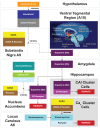Attention-deficit-hyperactivity disorder and reward deficiency syndrome
- PMID: 19183781
- PMCID: PMC2626918
- DOI: 10.2147/ndt.s2627
Attention-deficit-hyperactivity disorder and reward deficiency syndrome
Abstract
Molecular genetic studies have identified several genes that may mediate susceptibility to attention deficit hyperactivity disorder (ADHD). A consensus of the literature suggests that when there is a dysfunction in the "brain reward cascade," especially in the dopamine system, causing a low or hypo-dopaminergic trait, the brain may require dopamine for individuals to avoid unpleasant feelings. This high-risk genetic trait leads to multiple drug-seeking behaviors, because the drugs activate release of dopamine, which can diminish abnormal cravings. Moreover, this genetic trait is due in part to a form of a gene (DRD(2) A1 allele) that prevents the expression of the normal laying down of dopamine receptors in brain reward sites. This gene, and others involved in neurophysiological processing of specific neurotransmitters, have been associated with deficient functions and predispose individuals to have a high risk for addictive, impulsive, and compulsive behavioral propensities. It has been proposed that genetic variants of dopaminergic genes and other "reward genes" are important common determinants of reward deficiency syndrome (RDS), which we hypothesize includes ADHD as a behavioral subtype. We further hypothesize that early diagnosis through genetic polymorphic identification in combination with DNA-based customized nutraceutical administration to young children may attenuate behavioral symptoms associated with ADHD. Moreover, it is concluded that dopamine and serotonin releasers might be useful therapeutic adjuncts for the treatment of other RDS behavioral subtypes, including addictions.
Keywords: attention deficit hyperactivity disorder (ADHD); genes; neuropsychological deficits; reward deficiency syndrome; reward dependence; treatment.
Figures


Similar articles
-
Relationship between dopaminergic neurotransmission, alcoholism, and Reward Deficiency syndrome.Am J Med Genet B Neuropsychiatr Genet. 2005 Jan 5;132B(1):29-37. doi: 10.1002/ajmg.b.30080. Am J Med Genet B Neuropsychiatr Genet. 2005. PMID: 15457501 Review.
-
Reward deficiency syndrome: a biogenetic model for the diagnosis and treatment of impulsive, addictive, and compulsive behaviors.J Psychoactive Drugs. 2000 Nov;32 Suppl:i-iv, 1-112. doi: 10.1080/02791072.2000.10736099. J Psychoactive Drugs. 2000. PMID: 11280926 Review.
-
Activation instead of blocking mesolimbic dopaminergic reward circuitry is a preferred modality in the long term treatment of reward deficiency syndrome (RDS): a commentary.Theor Biol Med Model. 2008 Nov 12;5:24. doi: 10.1186/1742-4682-5-24. Theor Biol Med Model. 2008. PMID: 19014506 Free PMC article. Review.
-
Reward deficiency syndrome: genetic aspects of behavioral disorders.Prog Brain Res. 2000;126:325-41. doi: 10.1016/S0079-6123(00)26022-6. Prog Brain Res. 2000. PMID: 11105655 Review.
-
Should Reward Deficiency Syndrome (RDS) Be Considered an Umbrella Disorder for Mental Illness and Associated Genetic and Epigenetic Induced Dysregulation of Brain Reward Circuitry?J Pers Med. 2022 Oct 14;12(10):1719. doi: 10.3390/jpm12101719. J Pers Med. 2022. PMID: 36294858 Free PMC article.
Cited by
-
A New Paradigm for Training Hyperactive Dopamine Transporter Knockout Rats: Influence of Novel Stimuli on Object Recognition.Front Behav Neurosci. 2021 Apr 22;15:654469. doi: 10.3389/fnbeh.2021.654469. eCollection 2021. Front Behav Neurosci. 2021. PMID: 33967714 Free PMC article.
-
Study of Internet addiction in children with attention-deficit hyperactivity disorder and normal control.Ind Psychiatry J. 2018 Jan-Jun;27(1):110-114. doi: 10.4103/ipj.ipj_47_17. Ind Psychiatry J. 2018. PMID: 30416301 Free PMC article.
-
The Ankyrin Repeat and Kinase Domain Containing 1 Gene Polymorphism (ANKK1Taq1A) and Personality Traits in Addicted Subjects.Int J Environ Res Public Health. 2019 Jul 27;16(15):2687. doi: 10.3390/ijerph16152687. Int J Environ Res Public Health. 2019. PMID: 31357601 Free PMC article.
-
Amphetamines in child medicine: a review of ClinicalTrials.gov.Front Pharmacol. 2023 Oct 3;14:1280562. doi: 10.3389/fphar.2023.1280562. eCollection 2023. Front Pharmacol. 2023. PMID: 37854716 Free PMC article.
-
Sexual development in ADHD and internet pornography consumption.Front Psychiatry. 2023 Aug 8;14:1240222. doi: 10.3389/fpsyt.2023.1240222. eCollection 2023. Front Psychiatry. 2023. PMID: 37614646 Free PMC article.
References
-
- Andreazza AC, Frey BN, Valvassori SS, et al. DNA damage in rats after treatment with methylphenidate. Prog Neuropsychopharmacol Biol Psychiatry. 2007;31:1282–8. - PubMed
-
- APA. Diagnostic and statistical manual of mental disorders (DSM-IV) Washington, D.C: American Psychiatric Association; 1994.
-
- APA. Diagnostic and statistical manual of the American Psychiatric Association. Washington, DC: American Psychiatric Association; 2000.
-
- Asherson P, Kuntsi J, Taylor E. Unravelling the complexity of attention-deficit hyperactivity disorder: a behavioural genomic approach. Br J Psychiatry. 2005;187:103–5. - PubMed
Grants and funding
LinkOut - more resources
Full Text Sources
Other Literature Sources

